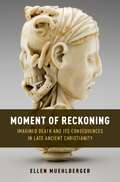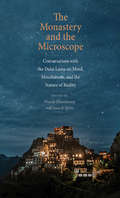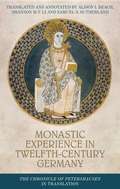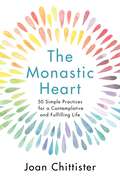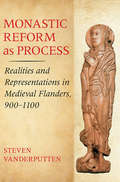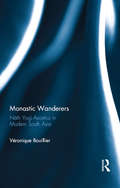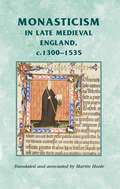- Table View
- List View
Moment of Reckoning: Imagined Death and Its Consequences in Late Ancient Christianity
by Ellen MuehlbergerLate antiquity saw a proliferation of Christian texts dwelling on the emotions and physical sensations of dying, not as a heroic martyr in a public square or a judge's court, but as an individual, at home in a bed or in a private room. In sermons, letters, and ascetic traditions, late ancient Christians imagined the last minutes of life and the events that followed death in elaborate detail. The majority of these imagined scenarios linked the quality of the experience to the moral state of the person who died. Death was no longer the "happy ending," in Judith Perkins's words, it had been to Christians of the first three centuries, an escape from the difficult and painful world. Instead, death was most often imagined as a terrifying, desperate experience. This book is the first to trace how, in late ancient Christianity, death came to be thought of as a moment of reckoning: a physical ordeal whose pain is followed by an immediate judgment of one's actions by angels and demons and, after that, fitting punishment. Because late ancient Christian culture valued the use of the imagination as a religious tool and because Christian teachers encouraged Christians to revisit the prospect of their deaths often, this novel description of death was more than an abstract idea. Rather, its appearance ushered in a new ethical sensibility among Christians, in which one's death was to be imagined frequently and anticipated in detail. This was, at first glance, meant as a tool for individuals: preachers counted on the fact that becoming aware of a judgment arriving at the end of one's life tends to sharpen one's scruples. But, as this book argues, the change in Christian sensibility toward death did not just affect individuals. Once established, it shifted the ethics of Christianity as a tradition. This is because death repeatedly and frequently imagined as the moment of reckoning created a fund of images and ideas about what constituted a human being and how variances in human morality should be treated. This had significant effects on the Christian assumption of power in late antiquity, especially in the case of the capacity to authorize violence against others. The thinking about death traced here thus contributed to the seemingly paradoxical situation in which Christians proclaimed their identity with a crucified person, yet were willing to use force against their ideological opponents.
Momentos de quietud con Dios: 365 inspiraciones diarias
by Joyce MeyerStart your day with peaceful meditations, soulful inspirations, and encouraging Bible verses in this 365-day devotional from bestselling author Joyce Meyer -- and grow spiritually as you spend time with God.Life is busy and often uncertain, but you can live in the full peace of God with this easy-to-understand devotional designed to encourage you each day of the year. This includes a daily Bible verse followed by a devotional reading and power thought to meditate upon.With the constant demands and pressures, it can be hard to regularly take time to unplug and simply be with God. But Joyce's practical teaching format in Quiet Times with God will encourage you to discipline yourself so that you can receive the fullness of God's healing, revitalizing peace.
A Mommy in Mind (A Tiny Blessings Tale #4)
by Arlene JamesTo: Pilar From: Ramon Re: A mommy for Lucia But which one?
Mommy Wanted: The Cowboy's Reunited Family The Forest Ranger's Return Mommy Wanted (Mills And Boon Love Inspired Ser.)
by Renee AndrewsA MOTHER’S HOPE
MOMumental: Adventures in the Messy Art of Raising a Family
by Jennifer GrantCelebrating the joyous art of being a mother, MOMumental offers an inspiring, honest, and infectiously humorous look at the perils and pleasures of raising a family in the real world.Once a devout believer in the myth of the perfect mother, author Jennifer Grant now has a more realistic yet still upbeat view of parenting and families. Instead of focusing on creating a conflict-free home, raising picture-perfect kids, and being an ideal mother, Grant offers a wiser and more down-to-earth way to love your children that makes room for mistakes and imperfections. She says, "I share stories about family life and how I've come to appreciate the mess of it. I am grateful for my own happy, idiosyncratic, and imperfect family."MOMumental is one mother's account of the unpredictable, creative, sometimes hilarious, and always rewarding process of raising a family. It's filled with funny and poignant stories from her everyday life-a life that mothers everywhere can identify with.MOMumental is a book about parenting, family, and intentional relationships for readers who normally avoid such fare like an overzealous street evangelist. (Raises hand.) Its wit and wisdom completely enraptured me. A delightful and surprising gift to us all.Cathleen Falsaniaward-winning journalist and author
Monarchy, religion and the state: Civil religion in the United Kingdom, Canada, Australia and the Commonwealth
by Norman BonneyThis most thorough and contemporary examination of the religious features of the UK state and its monarchy argues that the long reign of Elizabeth has led to a widespread lack of awareness of the centuries old religious features of the state that are revealed at the accession and coronation of a new monarch. It is suggested that the next succession to the throne will require major national debates in each realm of the monarch to judge whether the traditional rituals which require professions of Christianity and Protestantism by the new monarch are appropriate, or whether they might be replaced by alternative secular or interfaith ceremonies.It will be required reading for those who study the government and politics of the UK, Canada, Australia and the other 13 realms of the monarch. It will also appeal to as well as students and lecturers in history, sociology and religious studies and citizens interested in the monarchy and contemporary religious issues.
Monarchy, religion and the state: Civil religion in the United Kingdom, Canada, Australia and the Commonwealth
by Norman BonneyThis most thorough and contemporary examination of the religious features of the UK state and its monarchy argues that the long reign of Elizabeth has led to a widespread lack of awareness of the centuries old religious features of the state that are revealed at the accession and coronation of a new monarch. It is suggested that the next succession to the throne will require major national debates in each realm of the monarch to judge whether the traditional rituals which require professions of Christianity and Protestantism by the new monarch are appropriate, or whether they might be replaced by alternative secular or interfaith ceremonies.It will be required reading for those who study the government and politics of the UK, Canada, Australia and the other 13 realms of the monarch. It will also appeal to as well as students and lecturers in history, sociology and religious studies and citizens interested in the monarchy and contemporary religious issues.
The Monastery and the Microscope: Conversations with the Dalai Lama on Mind, Mindfulness, and the Nature of Reality
by Wendy Hasenkamp Janna R. WhiteAn illuminating record of dialogues between the Dalai Lama and some of today’s most prominent scientists, philosophers, and contemplatives In 2013, during a historic six-day meeting at a Tibetan monastery in southern India, the Dalai Lama gathered with leading scientists, philosophers, and monks for in-depth discussions on the nature of reality, consciousness, and the human mind. This eye-opening book presents a record of those spirited and wide-ranging dialogues, featuring contributions from prominent scholars like Richard Davidson, Matthieu Ricard, Tania Singer, and Arthur Zajonc as they address such questions as: Does nature have a nature? Do you need a brain to be conscious? Can we change our minds and brains through meditation? Throughout, the contributors explore the exciting and sometimes surprising commonalities between Western scientific and Tibetan Buddhist methods of perceiving, investigating, and knowing. Part history, part state-of-the-field, part inspiration for the future, this book rigorously and accessibly explores what these two investigative traditions can teach each other, and what that can tell us about ourselves and the world.
A Monastery in Time: The Making of Mongolian Buddhism
by Caroline Humphrey Hurelbaatar UjeedA Monastery in Time is the first book to describe the life of a Mongolian Buddhist monastery—the Mergen Monastery in Inner Mongolia—from inside its walls. From the Qing occupation of the eighteenth and nineteenth centuries through the Cultural Revolution, Caroline Humphrey and Hürelbaatar Ujeed tell a story of religious formation, suppression, and survival over a history that spans three centuries. Often overlooked in Buddhist studies, Mongolian Buddhism is an impressively self-sustaining tradition whose founding lama, the Third Mergen Gegen, transformed Tibetan Buddhism into an authentic counterpart using the Mongolian language. Drawing on fifteen years of fieldwork, Humphrey and Ujeed show how lamas have struggled to keep Mergen Gegen’s vision alive through tremendous political upheaval, and how such upheaval has inextricably fastened politics to religion for many of today’s practicing monks. Exploring the various ways Mongolian Buddhists have attempted to link the past, present, and future, Humphrey and Ujeed offer a compelling study of the interplay between the individual and the state, tradition and history.
A Monastery in Time: The Making of Mongolian Buddhism
by Caroline Humphrey Hurelbaatar UjeedA Monastery in Time is the first book to describe the life of a Mongolian Buddhist monastery—the Mergen Monastery in Inner Mongolia—from inside its walls. From the Qing occupation of the eighteenth and nineteenth centuries through the Cultural Revolution, Caroline Humphrey and Hürelbaatar Ujeed tell a story of religious formation, suppression, and survival over a history that spans three centuries. Often overlooked in Buddhist studies, Mongolian Buddhism is an impressively self-sustaining tradition whose founding lama, the Third Mergen Gegen, transformed Tibetan Buddhism into an authentic counterpart using the Mongolian language. Drawing on fifteen years of fieldwork, Humphrey and Ujeed show how lamas have struggled to keep Mergen Gegen’s vision alive through tremendous political upheaval, and how such upheaval has inextricably fastened politics to religion for many of today’s practicing monks. Exploring the various ways Mongolian Buddhists have attempted to link the past, present, and future, Humphrey and Ujeed offer a compelling study of the interplay between the individual and the state, tradition and history.
A Monastery in Time: The Making of Mongolian Buddhism
by Caroline Humphrey Hurelbaatar UjeedA Monastery in Time is the first book to describe the life of a Mongolian Buddhist monastery—the Mergen Monastery in Inner Mongolia—from inside its walls. From the Qing occupation of the eighteenth and nineteenth centuries through the Cultural Revolution, Caroline Humphrey and Hürelbaatar Ujeed tell a story of religious formation, suppression, and survival over a history that spans three centuries. Often overlooked in Buddhist studies, Mongolian Buddhism is an impressively self-sustaining tradition whose founding lama, the Third Mergen Gegen, transformed Tibetan Buddhism into an authentic counterpart using the Mongolian language. Drawing on fifteen years of fieldwork, Humphrey and Ujeed show how lamas have struggled to keep Mergen Gegen’s vision alive through tremendous political upheaval, and how such upheaval has inextricably fastened politics to religion for many of today’s practicing monks. Exploring the various ways Mongolian Buddhists have attempted to link the past, present, and future, Humphrey and Ujeed offer a compelling study of the interplay between the individual and the state, tradition and history.
A Monastery in Time: The Making of Mongolian Buddhism
by Caroline Humphrey Hurelbaatar UjeedA Monastery in Time is the first book to describe the life of a Mongolian Buddhist monastery—the Mergen Monastery in Inner Mongolia—from inside its walls. From the Qing occupation of the eighteenth and nineteenth centuries through the Cultural Revolution, Caroline Humphrey and Hürelbaatar Ujeed tell a story of religious formation, suppression, and survival over a history that spans three centuries. Often overlooked in Buddhist studies, Mongolian Buddhism is an impressively self-sustaining tradition whose founding lama, the Third Mergen Gegen, transformed Tibetan Buddhism into an authentic counterpart using the Mongolian language. Drawing on fifteen years of fieldwork, Humphrey and Ujeed show how lamas have struggled to keep Mergen Gegen’s vision alive through tremendous political upheaval, and how such upheaval has inextricably fastened politics to religion for many of today’s practicing monks. Exploring the various ways Mongolian Buddhists have attempted to link the past, present, and future, Humphrey and Ujeed offer a compelling study of the interplay between the individual and the state, tradition and history.
A Monastery in Time: The Making of Mongolian Buddhism
by Caroline Humphrey Hurelbaatar UjeedA Monastery in Time is the first book to describe the life of a Mongolian Buddhist monastery—the Mergen Monastery in Inner Mongolia—from inside its walls. From the Qing occupation of the eighteenth and nineteenth centuries through the Cultural Revolution, Caroline Humphrey and Hürelbaatar Ujeed tell a story of religious formation, suppression, and survival over a history that spans three centuries. Often overlooked in Buddhist studies, Mongolian Buddhism is an impressively self-sustaining tradition whose founding lama, the Third Mergen Gegen, transformed Tibetan Buddhism into an authentic counterpart using the Mongolian language. Drawing on fifteen years of fieldwork, Humphrey and Ujeed show how lamas have struggled to keep Mergen Gegen’s vision alive through tremendous political upheaval, and how such upheaval has inextricably fastened politics to religion for many of today’s practicing monks. Exploring the various ways Mongolian Buddhists have attempted to link the past, present, and future, Humphrey and Ujeed offer a compelling study of the interplay between the individual and the state, tradition and history.
A Monastery in Time: The Making of Mongolian Buddhism
by Caroline Humphrey Hurelbaatar UjeedA Monastery in Time is the first book to describe the life of a Mongolian Buddhist monastery—the Mergen Monastery in Inner Mongolia—from inside its walls. From the Qing occupation of the eighteenth and nineteenth centuries through the Cultural Revolution, Caroline Humphrey and Hürelbaatar Ujeed tell a story of religious formation, suppression, and survival over a history that spans three centuries. Often overlooked in Buddhist studies, Mongolian Buddhism is an impressively self-sustaining tradition whose founding lama, the Third Mergen Gegen, transformed Tibetan Buddhism into an authentic counterpart using the Mongolian language. Drawing on fifteen years of fieldwork, Humphrey and Ujeed show how lamas have struggled to keep Mergen Gegen’s vision alive through tremendous political upheaval, and how such upheaval has inextricably fastened politics to religion for many of today’s practicing monks. Exploring the various ways Mongolian Buddhists have attempted to link the past, present, and future, Humphrey and Ujeed offer a compelling study of the interplay between the individual and the state, tradition and history.
Monastic And Religious Orders In Britain, 1000-1300 (PDF)
by Janet E. BurtonThis book traces the development of monasticism in England, Scotland and Wales from the last half century of Anglo-Saxon England to 1300. It explores the nature of the impact of the Norman settlement on monastic life, and how Britain responded to new, European ideas on monastic life. In particular, it examines Britain's response to the needs of religious women. It covers every aspect of the life and work of the religious orders: their daily life, the buildings in which they lived, their contribution to intellectual developments and to the economy. Particular attention is paid to the relationship between religious houses and their founders and patrons. This shows the degree of dependence of religious houses on local patrons. Indeed, one major theme which emerges from the book is the constant tension between the ideals of monastic communities and the demands of the world.
Monastic experience in twelfth-century Germany: The Chronicle of Petershausen in translation
by Alison I. Beach Shannon M. Li Samuel SutherlandMonastic experience in twelfth-century Germany provides a rare window on to monastery life in the tumultuous world of twelfth-century Swabia. From its founding in 992 through the great fire that ravaged it in 1159 and beyond, Petershausen weathered countless external attacks and internal divisions. Supra-regional clashes between emperors and popes played out at the most local level. Monks struggled against overreaching bishops. Reformers introduced new and unfamiliar customs. Tensions erupted into violence within the community. Through it all the anonymous chronicler struggled to find meaning amid conflict and forge connections to a shared past, enlivening his narrative with colorful anecdotes – sometimes amusing, sometimes disturbing. Translated into English for the first time, this fascinating text is an essential source for the lived experience of medieval monasticism.
Monastic experience in twelfth-century Germany: The Chronicle of Petershausen in translation
by Alison I. Beach Shannon M. Li Samuel SutherlandMonastic experience in twelfth-century Germany provides a rare window on to monastery life in the tumultuous world of twelfth-century Swabia. From its founding in 992 through the great fire that ravaged it in 1159 and beyond, Petershausen weathered countless external attacks and internal divisions. Supra-regional clashes between emperors and popes played out at the most local level. Monks struggled against overreaching bishops. Reformers introduced new and unfamiliar customs. Tensions erupted into violence within the community. Through it all the anonymous chronicler struggled to find meaning amid conflict and forge connections to a shared past, enlivening his narrative with colorful anecdotes – sometimes amusing, sometimes disturbing. Translated into English for the first time, this fascinating text is an essential source for the lived experience of medieval monasticism.
The Monastic Footprint in Post-Reformation Movements: The Cloister of the Soul (Routledge Methodist Studies Series)
by Kenneth C. CarveleyThis book examines the influence of the monastic tradition beyond the Reformation. Where the built monastic environment had been dissolved, desire for the spiritual benefits of monastic living still echoed within theological and spiritual writing of the seventeenth and eighteenth centuries as a virtual exegetical template. The volume considers how the writings of monastic authors were appropriated in post-Reformation movements by those seeking a more fervent spiritual life, and how the concept of an internal cloister of monastic/ascetic spirituality influenced several Anglican writers during the Restoration. There is a careful examination of the monastic influence upon the Wesleys and the foundation and rise of Methodism. Drawing on a range of primary sources, the book will be of particular interest to scholars of monastic and Methodist history, and to those engaged in researching ecclesiology and in ecumenical dialogues.
The Monastic Footprint in Post-Reformation Movements: The Cloister of the Soul (Routledge Methodist Studies Series)
by Kenneth C. CarveleyThis book examines the influence of the monastic tradition beyond the Reformation. Where the built monastic environment had been dissolved, desire for the spiritual benefits of monastic living still echoed within theological and spiritual writing of the seventeenth and eighteenth centuries as a virtual exegetical template. The volume considers how the writings of monastic authors were appropriated in post-Reformation movements by those seeking a more fervent spiritual life, and how the concept of an internal cloister of monastic/ascetic spirituality influenced several Anglican writers during the Restoration. There is a careful examination of the monastic influence upon the Wesleys and the foundation and rise of Methodism. Drawing on a range of primary sources, the book will be of particular interest to scholars of monastic and Methodist history, and to those engaged in researching ecclesiology and in ecumenical dialogues.
The Monastic Heart: 50 Simple Practices for a Contemplative and Fulfilling Life
by Sister Joan ChittisterActivist, nun and spiritual guide Joan Chittister invites us to create a monastery within ourselves: to cultivate wisdom and resilience, so we can live more easily and give of ourselves more fully, no matter our circumstances.'In every beating heart is a silent undercurrent that calls each of us to a place unknown, to the vision of a wiser life, to become what we feel we must be - but cannot name.' So begins Sister Joan Chittister's words on monasticism, offering a way of living and seeing life that brings deep human satisfaction. Amid the recent global disruptions, Sister Joan calls readers to cultivate the spiritual seeker within all of us, however that may look across our diverse journeys.The Monastic Heart carries the weight and wisdom of the Benedictine spiritual tradition into the twenty-first century. Sister Joan draws deeply from Saint Benedict, a young man who sought moral integrity in the face of an empire in the sixth century, not by conquering or overpowering the empire, but by simply living an ordinary life extraordinarily well. This same monastic mindset can help us grow in wisdom, equanimity and strength of soul as we seek restoration and renewal both at home and in the world. At a time when people around the world are bearing witness to human frailty - and, simultaneously, the endurance of the human spirit - The Monastic Heart invites readers to embrace a new beginning of faith. Without stepping foot in a monastery, we can become, like those before us, a deeper, freer self, a richer soul - and, as a result, a true monastic.'Essential reading for anyone wishing to find the compass of their heart and the wellspring from which to live fully.' Gregory Boyle, New York Times bestselling author of Tattoos on the Heart
Monastic Perspectives on Temporality: Time is a Mirage
by Riitta HujanenIn this book, Riitta Hujanen explores temporality in the context of Catholic enclosed contemplative traditions. It investigates, based on literature and other sources, what enclosed contemplatives might say about temporality through their monastic journeys. What makes a young person decide to dedicate their life inside a cloister? Do contemplatives have a preference for eternity over temporal time? How does the enclosed contemplative life impact one’s concept of time? How is time perceived towards the end of one’s monastic journey? What is seen when looking back to the years in the enclosed contemplative life? What is experienced at the hour of death?The answers to these questions illustrate a paradoxical dynamic in monastic journeys that cover a broad historical scope from the earliest monastic writers to contemporary sources.
Monastic Reform as Process: Realities and Representations in Medieval Flanders, 900–1100
by Steven VanderputtenThe history of monastic institutions in the Middle Ages may at first appear remarkably uniform and predictable. Medieval commentators and modern scholars have observed how monasteries of the tenth to early twelfth centuries experienced long periods of stasis alternating with bursts of rapid development known as reforms. Charismatic leaders by sheer force of will, and by assiduously recruiting the support of the ecclesiastical and lay elites, pushed monasticism forward toward reform, remediating the inevitable decline of discipline and government in these institutions. A lack of concrete information on what happened at individual monasteries is not regarded as a significant problem, as long as there is the possibility to reconstruct the reformers’ ‘‘program.’’ While this general picture makes for a compelling narrative, it doesn’t necessarily hold up when one looks closely at the history of specific institutions.In Monastic Reform as Process, Steven Vanderputten puts the history of monastic reform to the test by examining the evidence from seven monasteries in Flanders, one of the wealthiest principalities of northwestern Europe, between 900 and 1100. He finds that the reform of a monastery should be studied not as an "exogenous shock" but as an intentional blending of reformist ideals with existing structures and traditions. He also shows that reformist government was cumulative in nature, and many of the individual achievements and initiatives of reformist abbots were only possible because they built upon previous achievements. Rather than looking at reforms as "flashpoint events," we need to view them as processes worthy of study in their own right. Deeply researched and carefully argued, Monastic Reform as Process will be essential reading for scholars working on the history of monasteries more broadly as well as those studying the phenomenon of reform throughout history.
Monastic Wanderers: Nāth Yogī Ascetics in Modern South Asia
by Veronique BouillierHow have the premodern Shaiva ascetic sect of the Nāth Yogīs (known also as the Yogīs with splitted ears) succeeded in maintaining its presence and importance until today? This book intends to give a general survey of this sampradāya which is said to have been founded by the Siddha Gorakhnāth, known for his strong link to Haṭha Yoga. However, rather than to Yoga, the history and expansion of the Nāth sect are linked to its rich legendary corpus. Dealing first with the marks of belonging (such as the huge earrings worn by the fully initiated Yogīs) which give the sect its unity, the book then focuses on its organization and explores the dialectics between the wandering Yogīs and the monastic settlements. The Nāth monasteries belong to two categories: the pañcāyati maṭhs, collectively owned and managed by the sectarian authorities, which ensure the permanency of the sect, and the nījī maṭhs, owned on a personal basis and transmitted from guru to disciple, which permits innovative initiatives The book gives a detailed account of two pañcāyati monasteries, the Kadri Maṭh of Mangalore where its head’s enthronement is spectacularly performed every twelve years, and the Caughera Maṭh of Dang Valley in Nepal, the royal foundation of which gives a glimpse of the complex relationships that can exist between monasteries and kingdoms. It then focuses on three nījī maṭhs: Amritashram in Fatehpur (Rajasthan), Ashtal Bohar in Rohtak (Haryana) and the Gorakhpur mandir (UP). Each of them shows a different mode of adaptation to a modern context and attests of the present importance and continuity of this pluri-secular tradition of asceticism.
Monastic Wanderers: Nāth Yogī Ascetics in Modern South Asia
by Veronique BouillierHow have the premodern Shaiva ascetic sect of the Nāth Yogīs (known also as the Yogīs with splitted ears) succeeded in maintaining its presence and importance until today? This book intends to give a general survey of this sampradāya which is said to have been founded by the Siddha Gorakhnāth, known for his strong link to Haṭha Yoga. However, rather than to Yoga, the history and expansion of the Nāth sect are linked to its rich legendary corpus. Dealing first with the marks of belonging (such as the huge earrings worn by the fully initiated Yogīs) which give the sect its unity, the book then focuses on its organization and explores the dialectics between the wandering Yogīs and the monastic settlements. The Nāth monasteries belong to two categories: the pañcāyati maṭhs, collectively owned and managed by the sectarian authorities, which ensure the permanency of the sect, and the nījī maṭhs, owned on a personal basis and transmitted from guru to disciple, which permits innovative initiatives The book gives a detailed account of two pañcāyati monasteries, the Kadri Maṭh of Mangalore where its head’s enthronement is spectacularly performed every twelve years, and the Caughera Maṭh of Dang Valley in Nepal, the royal foundation of which gives a glimpse of the complex relationships that can exist between monasteries and kingdoms. It then focuses on three nījī maṭhs: Amritashram in Fatehpur (Rajasthan), Ashtal Bohar in Rohtak (Haryana) and the Gorakhpur mandir (UP). Each of them shows a different mode of adaptation to a modern context and attests of the present importance and continuity of this pluri-secular tradition of asceticism.
Monasticism in late medieval England, c.1300–1535 (Manchester Medieval Sources)
by Martin HealeMonasticism in late medieval England, c.1300-1535 provides the first collection of translated sources on this subject. The volume covers both male and female houses of all orders and sizes, and offers a range of new perspectives on the character and reputation of English monasteries in the later middle ages.The first section surveys the internal affairs of English monasteries, including recruitment, the monastic economy, standards of observance and learning. The second part looks at the relations between monasteries and the world, exploring the monastic contribution to late medieval religion and society and lay attitudes towards monks and nuns in the years leading up to the Dissolution.This book is an ideal introduction to this topic for students and scholars. Supported by an extended and accessible introduction this collection of documents gives an unrivalled insight into the last phase of monastic life in medieval England.
